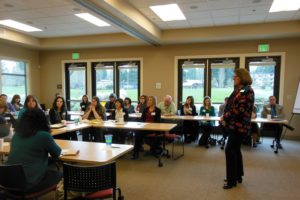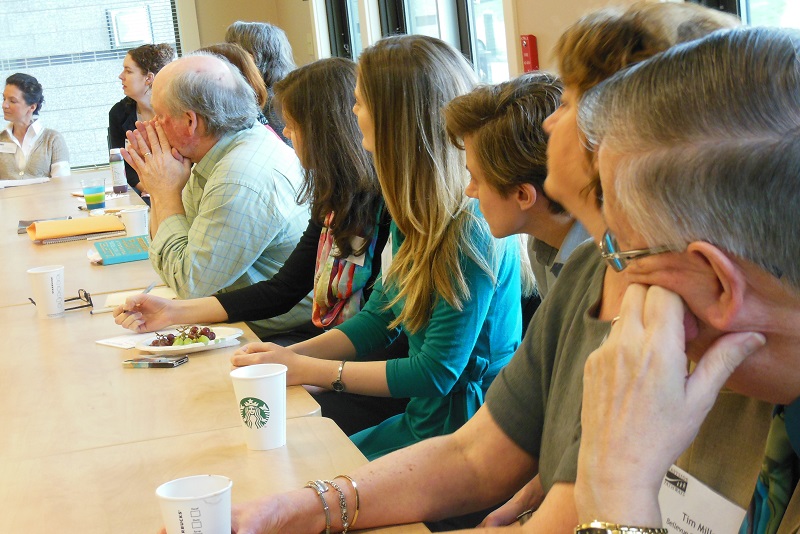 Executives from over 30 Eastside Pathways partner organizations came together on March 7 to discuss the accountability and decision making structure of the partnership and to network.
Executives from over 30 Eastside Pathways partner organizations came together on March 7 to discuss the accountability and decision making structure of the partnership and to network.
“The Eastside Pathways partnership came about to serve the needs of this community. We are aligned by a common vision and goals and backed by common measurement practices,” said Stephanie Cherrington, executive director of Eastside Pathways. “It is because we hold one another individually accountable and collectively responsible for better results that we are making a difference.”
Eastside Pathways has matured from a small group in June 2011 to now a partnership of 46 organizations and a backbone organization comprised of three staff members and nine volunteer staff.
“We need to think about how we are going to make decisions as a collective,” Cherrington said. “Sometimes, the backbone organization is making decisions for the entire partnership. That’s not always comfortable or the right thing to do, because the entire partnership should be included in certain decisions.”
Cherrington explained that when publications have the logos of all the partners, such as the Eastside Pathways Baseline Report, or when money is involved in various decisions, such as the Community Café model, it is especially important to understand how the partnership would like to be involved in these various decisions.
 “There are several options of how decisions might be made and it is important to find one that works for us. Way back in the beginning, we chose not to follow the Strive model, which is structured around funders, because we believed what would make the most sense for our community would be to go directly to service providers,” said Roxanne Shepherd, executive director of the Bellevue Schools Foundation and an Eastside Pathways co-founder and board member.
“There are several options of how decisions might be made and it is important to find one that works for us. Way back in the beginning, we chose not to follow the Strive model, which is structured around funders, because we believed what would make the most sense for our community would be to go directly to service providers,” said Roxanne Shepherd, executive director of the Bellevue Schools Foundation and an Eastside Pathways co-founder and board member.
In order to understand how to find a decision-making model for Eastside Pathways, Shepherd went over categories of important decisions, the meaning of consensus and possible friction points where the decision-making model would be needed.
The possible friction points included: anything involving partners’ money, anything involving the Eastside Pathways name and brand, how individual partners represent collective accomplishments, public advocacy around policy issues, and development or fundraising efforts.
“There is a right answer for us and it is different than what might work for other communities,” Shepherd said. “My theory is that the level of consensus and level of engagement needed will differ for each type of decision.”
During the meeting, a voting sheet was passed around to find out which decisions partner organizations deemed as issues they would be comfortable with the backbone/board deciding versus decisions with which partner organizations themselves needed to be involved.
The final results showed that partners absolutely wanted to be involved in decisions involving partners’ money (74 percent) and strategic direction and mission (52 percent), while they were comfortable with the Eastside Pathways board or backbone deciding issues involving development and fundraising (59 percent), the use of the Eastside Pathways name/brand (61 percent), and external communications (61 percent).
“One of the dangers that a group this large can run into is paralysis and not making a decision. The more partner involvement we have, the less decisions we [as a partnership] will need to make and consensus will be easier to reach,” said Patrick Foran, director of Bellevue Parks and Recreation and an Eastside Pathways co-founder and board member.
John Stokes, Bellevue City Council member and another Eastside Pathways co-founder and board member, had similar thoughts about the decision-making process.
“Some decisions everybody might want to buy in on but if it’s not that big then you have to look at it in terms of how many people need to buy in,” Stokes said. “The goal is to get as much consensus as possible on significant decisions. It comes down to the community and that’s going to make the community strong then.”
Paula Matthysse, outreach director of Eastside Community Network, explained the need to think about adaptive versus technical decisions.
“Adaptive challenges are not simple, are not easily solved, and require more thought, more understanding of the systems and different types of courageous conversations emerge,” Matthysse said. “Calling out the complexity, the systems at work, and where there is a place to look at decisions as part of the creation of the system looking forward and inward helps raise the awareness of the complexity and the potential to hold space for that which is not as black and white as a technical (fix) decision.”
Suzanne Sievert, founder of English Language Learners Alliance (ELLA), explained that, “It’s important for Eastside Pathways to decide on a decision-making structure because in an organization so large, with so many partners, it’s imperative that all partners are adequately represented in decision making because the outcomes might affect them.”
Although a decision-making model was not formally decided on at the meeting, a team of volunteers comprised of partner representatives will be working to take the input gained at the Executive meeting to draft a decision-making model.
“We need to learn what it means to work as a collective; we have to model collective impact behavior. We’ve talked a lot about each of us individually and naturally, our barometers are our organizations,” Foran said. “I’m thinking ultimately, it’s about coming back to what the real test is, and that test is what is best for our kids.
Article written by Charlotte Anthony.

